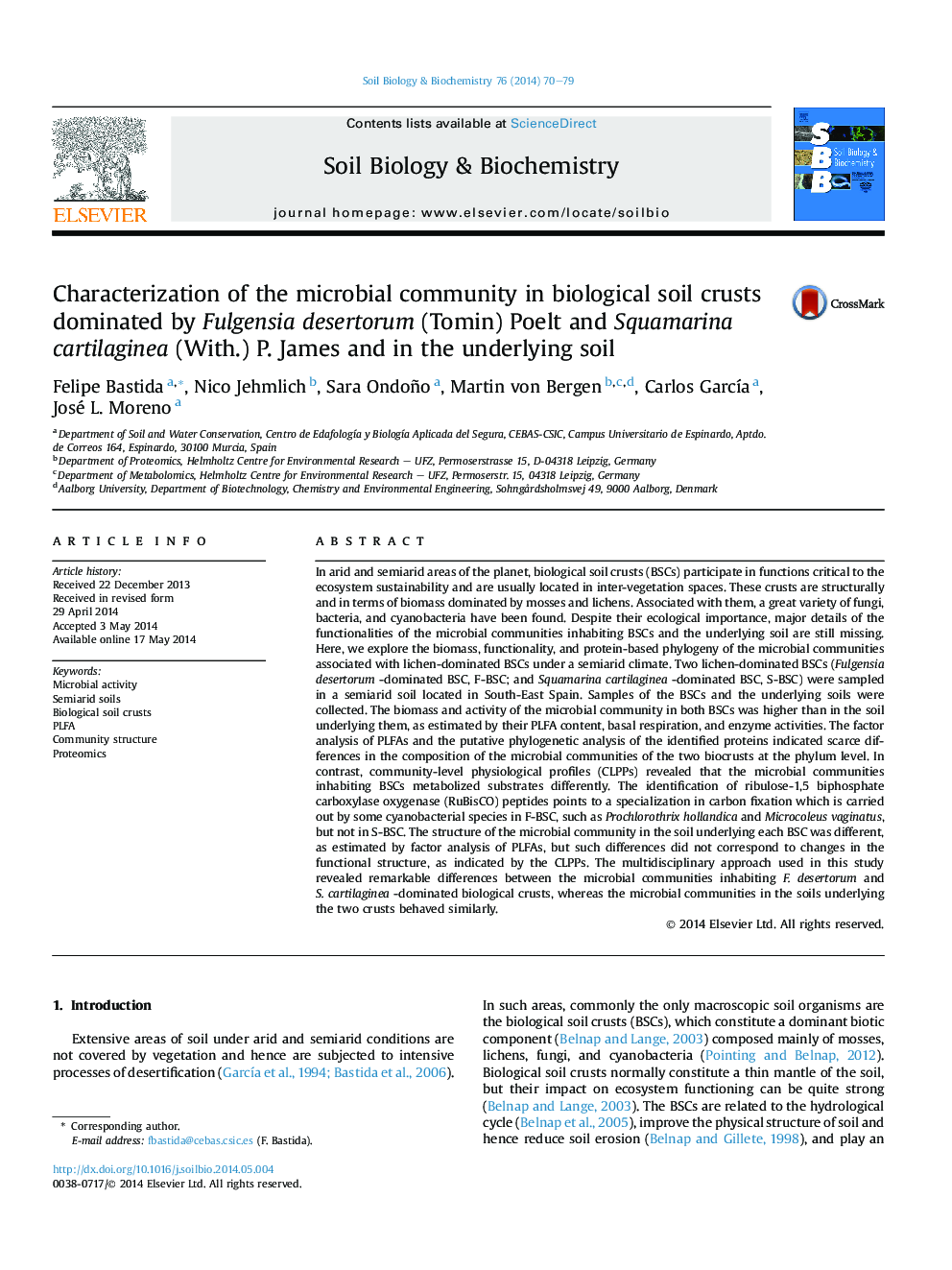| کد مقاله | کد نشریه | سال انتشار | مقاله انگلیسی | نسخه تمام متن |
|---|---|---|---|---|
| 8364550 | 1542608 | 2014 | 10 صفحه PDF | دانلود رایگان |
عنوان انگلیسی مقاله ISI
Characterization of the microbial community in biological soil crusts dominated by Fulgensia desertorum (Tomin) Poelt and Squamarina cartilaginea (With.) P. James and in the underlying soil
دانلود مقاله + سفارش ترجمه
دانلود مقاله ISI انگلیسی
رایگان برای ایرانیان
کلمات کلیدی
موضوعات مرتبط
علوم زیستی و بیوفناوری
علوم کشاورزی و بیولوژیک
دانش خاک شناسی
پیش نمایش صفحه اول مقاله

چکیده انگلیسی
In arid and semiarid areas of the planet, biological soil crusts (BSCs) participate in functions critical to the ecosystem sustainability and are usually located in inter-vegetation spaces. These crusts are structurally and in terms of biomass dominated by mosses and lichens. Associated with them, a great variety of fungi, bacteria, and cyanobacteria have been found. Despite their ecological importance, major details of the functionalities of the microbial communities inhabiting BSCs and the underlying soil are still missing. Here, we explore the biomass, functionality, and protein-based phylogeny of the microbial communities associated with lichen-dominated BSCs under a semiarid climate. Two lichen-dominated BSCs (Fulgensia desertorum -dominated BSC, F-BSC; and Squamarina cartilaginea -dominated BSC, S-BSC) were sampled in a semiarid soil located in South-East Spain. Samples of the BSCs and the underlying soils were collected. The biomass and activity of the microbial community in both BSCs was higher than in the soil underlying them, as estimated by their PLFA content, basal respiration, and enzyme activities. The factor analysis of PLFAs and the putative phylogenetic analysis of the identified proteins indicated scarce differences in the composition of the microbial communities of the two biocrusts at the phylum level. In contrast, community-level physiological profiles (CLPPs) revealed that the microbial communities inhabiting BSCs metabolized substrates differently. The identification of ribulose-1,5 biphosphate carboxylase oxygenase (RuBisCO) peptides points to a specialization in carbon fixation which is carried out by some cyanobacterial species in F-BSC, such as Prochlorothrix hollandica and Microcoleus vaginatus, but not in S-BSC. The structure of the microbial community in the soil underlying each BSC was different, as estimated by factor analysis of PLFAs, but such differences did not correspond to changes in the functional structure, as indicated by the CLPPs. The multidisciplinary approach used in this study revealed remarkable differences between the microbial communities inhabiting F. desertorum and S. cartilaginea -dominated biological crusts, whereas the microbial communities in the soils underlying the two crusts behaved similarly.
ناشر
Database: Elsevier - ScienceDirect (ساینس دایرکت)
Journal: Soil Biology and Biochemistry - Volume 76, September 2014, Pages 70-79
Journal: Soil Biology and Biochemistry - Volume 76, September 2014, Pages 70-79
نویسندگان
Felipe Bastida, Nico Jehmlich, Sara Ondoño, Martin von Bergen, Carlos GarcÃa, José L. Moreno,